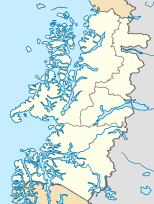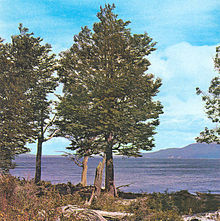Puerto Aysén
| Aisen | ||
|---|---|---|
| Location of the municipality in the Aisén region | ||
| Communal data | ||
| region | Aisen | |
| province | Aisen | |
| founding | January 28, 1928 | |
| Residents | 25,569 (2019) | |
| surface | 29,970.4 km² | |
| Population density | 1 inhabitant / km² | |
| Post Code | 6000000 | |
| prefix | + (56-) 67 | |
| Time zone | UTC −4 | |
| Alkalis | Marisol Martínez Sánchez | |
| Website | ||
| main place | ||
|
Puerto Aisen on the map of Chile |
||
| Surname | Puerto Aisen | |
| status | Ciudad | |
| Residents | 16,936 (2002) | |
| surface | 7.42 km² | |
| Population density | 2.282 inhabitants / km² | |
| View from the Presidente Ibáñez bridge | ||
Puerto Aisén , officially Puerto Aysén , is a small town in western Patagonia , southern Chile . It is the capital of the province of the same name in the XI. Region Región de Aysén and the administrative center of the municipality of Aysén with around 22,000 inhabitants (as of 2002), of which 88% live in closed settlement areas and 12% in rural areas. For 2012, the Spanish Wikipedia estimates the population at 35,476. Puerto Aysén is around 600 km south of Concepción and around 67 km west of Coihaique .
geography
The city is located at the confluence of the Río Los Palos in the Río Aisén . A few kilometers away is the small port town of Puerto Chacabuco with around 1700 inhabitants. From here you can take a ferry to Puerto Montt . A well-developed trunk road leads to Coihaique.
Much of the Chonos Archipelago and some national parks, such as the Reserva Nacional Río Simpson and the Laguna San Rafael National Park, belong to the municipality . Other localities in the municipality are Villa Mañihuales ( 45 ° 10 ′ S , 72 ° 9 ′ W ) and Puerto Aguirre ( 45 ° 10 ′ S , 73 ° 31 ′ W ) on the island of Las Huichas.
The climate is characterized by heavy rainfall (3000 mm / year). The mean temperature in summer is 8 ° C and in winter around −6 ° C.
economy
The city lives mainly from fishing and tourism. Around the city there are several large hydropower plants , as well as thermal power plants of the company 'EDELAYSEN S.A', which supply the Aisén region with electricity. The region obtains fuel and other supplies via the freight and passenger port of Port Chacabuco. From Chacabuco, agricultural products, such as live cattle, find their way to the more densely populated north.
tourism
To the east of Puerto Aysén is the Reserva Nacional Río Simpson . It is very species-rich with deep forests of southern Lenga beech (Nothofagus pumilio) . The deep granite canyons of the Rio Simpson and many lakes form further attractions.
Far to the west of the city lies the Laguna San Rafael National Park with its calving glaciers .
In 1968 the suspension bridge 'Puente Presidente Ibáñez' was spanned over the Río Aisén with a length of 210 m. It is now a national monument and an important tourist destination.
history
discovery

In 1763 the Jesuit Vicuña came on a missionary trip to the Aisén Fjord and drove there for four days over the Río Aisén, as far as it was navigable with his small boat. The inhabitants of this region were the Chonos , who lived in many small groups, mostly on the offshore islands. The Chonos called the region around the river Aisén . The thick forest prevented vicuña and his companions from penetrating deeper into the country. All they reached near what is now Puerto Aisén was to leave a cross carved into a tree.
The era of lumberjacks and ranchers
Modern colonization only began after Chile gained independence from Spain. The first colonists and lumberjacks came to the region individually and on their own initiative and settled where it seemed appropriate to them. So the first settlements developed many years before the Chilean state even took notice. Around 1880 a timber merchant from Chiloé, Ciriaco Álvarez, built a transshipment point for wood and facilities to supply his workers in the area between Puerto Aisén and Puerto Chacabuco. This entrepreneur, known as the "Cypress King", is considered to be the first colonist of Puerto Aisén.
In January to May 1897, the German geographer Hans Steffen explored the catchment area of the Río Aisén for the first time on behalf of the government, because the border between Chile and Argentina was to be determined on the continental divide . In 1901, at the instigation of the Border Commission, a 75 km long road was built from the Aisén Fjord along the Río Aisén inland. After the border had been determined in 1902, a cattle breeding boom ( Fiebre de las ganaderas ) began in western Patagonia. The following year the government awarded ten 20-year concessions to private entrepreneurs between Puerto Montt and Punta Arenas with the aim of promoting colonization in southern Chile. The concessionaire was allowed to cultivate the assigned area at his discretion and in return undertook to settle a certain number of colonists, maintain regular shipping connections with Puerto Montt and establish supply facilities.
The concessionaire for the area near Puerto Aisén was Luis Aguirre from Punta Arenas, who transferred his rights to the Sociedad Industrial del Aysén joint stock company after just a few months . Aguirre had good connections with Mauricio Braun, a wealthy entrepreneur and rancher from Punta Arenas. With his support, he was able to start the company well and immediately set up an estancia with 1715 cattle and 50 horses on the 827,000 hectare concession area . In 1904, Aguirre organized the recruitment and transport of 500 men, most of whom came from Chiloé , and in three years he expanded the 80 km long route from Puerto Chacabuco to Coihaique.
In 1913 the foundation stone was laid for Puerto Aisén with the construction of a factory for processing the cattle of the estancia. Puerto Aisén became a transshipment point for goods and cattle to and from Coihaique, the center of the estancia. The company made abundant profits and grew vigorously. The First World War made them earn even better money through rising prices for their products, especially wool. Around 1920 there were 158 men and 70 women in Puerto Aisén.
By 1926 the company had repeatedly evaded its obligation to settle colonists. When there was no other option, she finally awarded land to 106 people near Puerto Aisén. Instead of distributing cattle and materials to the settlers, as was probably originally intended, each was given 700 pesos as start-up capital. Only 54 of them took possession of their properties; the rest did not even care to find out where their properties were at all. Two years later, the subdivision was no longer recognizable as such.
State-organized colonization
In view of the obvious unwillingness and failure of the concessionaires, the Chilean state organized the colonization itself from 1928 onwards. On January 28, 1928, the Puerto Aisén administrative center was founded. At that time the place already consisted of about 20 houses, a shop, a hotel and a port facility. On December 26th, the city administration was established with a mayor and two city councilors. As a result of the development of the administration, many functionaries came to the place. By 1930 Puerto Aisén had 2051 residents. They made up almost a third of all residents of the Aisén region. In 1931/32 the judiciary and its auxiliary administrations were established. In 1934 a church was built.
In 1936 the place consisted of 330, mostly single-storey wooden houses, some of which were clad with sheet metal. On plots that were around 1250 m² there were houses with 80 to 90 m², with L- or U-shaped floor plans and with canopies.
See also
literature
- Adolfo Ibáñez Santa María: La incorporación de Aisén a la vida nacional, 1902-1936 . In: Pontificia Universidad Católica de Chile, Instituto de Historia (ed.): Historia . No. 11, (1972-1973) . Universitaria, Santiago de Chile 1961, p. 259-378 (Spanish, Memoria Chilena documents ).
- José M. Pomar: La concesión del Aisén y el valle Simpson (notas y recuerdos de un viaje de inspección en Mayo y June de 1920) . Imprenta Cervantes, Santiago de Chile 1923 (Spanish, Memoria Chilena - documents (book); Memoria Chilena - documents [appendix to the book]).
- Hans Steffen : Relación de un viaje de esploración al Río Aisén: diciembre de 1896 - mayo de 1897 por el Dr. Hans Steffen . In: Viajes de esploración i estudio en la Patagonia occidental 1892–1902 . tape 2 . Imprenta Cervantes, Santiago de Chile 1910, p. 74-180 (Spanish, Memoria Chilena documents ).






